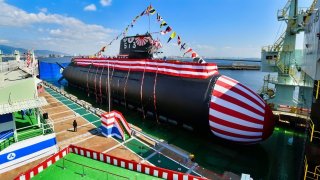Taigei-Class: The Latest Stealth Submarine from Japan Is a Classic
As tensions rise in the Pacific, Japan's Maritime Self-Defense Force has commissioned its latest Taigei-class submarines to counter Chinese and North Korean aggression.
Summary and Key Points: As tensions rise in the Pacific, Japan's Maritime Self-Defense Force has commissioned its latest Taigei-class submarines to counter Chinese and North Korean aggression.

-The diesel-electric Taigei-class, including the lead ship Taigei and Hakugei, features advanced stealth, high-strength steel, and sophisticated lithium-ion batteries for enhanced underwater endurance.
-Armed with Type 18 and Type 89 torpedoes, and UGM-48 Harpoon missiles, these subs significantly bolster Japan's naval capabilities.
-With a displacement of 3,000 tons and cutting-edge technology, the Taigei-class is crucial for Japan's defense strategy. Analysts predict at least ten of these submarines will be built by 2027.
Japan’s Taigei-class Submarines: A Profile
As the People’s Republic of China (PRC) continues to engage in hostile activity in the Pacific, East Asian nations are gearing up for a potential full-blown war in the imminent future. Earlier this year, the Japan Maritime Self-Defense Force (JMSDF) commissioned its newest Taigei-class submarine. This diesel-electric boat dubbed “Swift Whale” is expected to officially commence its operational service with Japan over the next year. Since the South China Sea would serve as the hotbed for kinetic conflict, Japan’s growing naval capabilities are of the utmost importance to its security.
Introducing the Taigei-class
Japan’s Taigei-class submarines represent the country’s latest efforts to counter increased Chinese and North Korean aggression. The preceding Soryu boats were initially developed with this goal in mind and some of the class’s capabilities were transferred to the Taigei vessels. Before the final Soryu sub was commissioned, Japanese officials envisioned a “next-generation” submarine class that would prioritize stealth, dive speed, and other emerging technologies.

Evaluations for this future class’s sonar and air-independent propulsion system (AIP) were initiated in the early 2000s. This new AIP system was conceptualized to allow future submarine classes to expand their operational areas, a capability required by the JMSDF.
Specs & Capabilities
The lead ship of the Taigei class—Taigei—was commissioned in 2022 at the Yokosuka home port. It was followed by Hakugei one year later at the Kure home port. The Taigei submarines have a standard displacement of roughly 3,000 tons, which is larger than their Soryu predecessors. Each of these boas can carry a crew of about seven sailors and measures around 84 meters in length. These submarines notably feature sophisticated absorbent materials and high-strength steel to ensure a quieter operation and high water pressure resistance. When the fourth Taigei boat is introduced to service down the line, Raigei will notably feature the latest Kawasaki 12V 25/31 diesel engine unlike its sister ships.
Unlike other non-nuclear submarines that have been constructed, the Taigei boats feature lithium-ion batteries which provide faster recharge times, enhanced battery-discharge rates and higher energy density. The U.S. Naval Institute has previously outlined just how capable these batteries are: “The results are enhanced silent operations, better speeds and sprints, longer underwater endurance, and significantly greater overall performance when compared with more conventional undersea submarines. The use of lithium-ion batteries also saves weight and complexity by making an air-independent propulsion (AIP) system unnecessary to extend the submarine’s underwater endurance.”
Weapons
In terms of armament power, the Taigei class is quite lethal. The submarines are able to launch Japan’s newest Type 18 heavyweight torpedoes or Mitsuishi-built Type 89 heavyweight homing torpedoes via its six 21-inch bow torpedo tubes. Additionally, the Taigei boats can launch UGM-48 Harpoon anti-ship missiles. The missile range of the Harpoon is 248 km—enough to provide Japan with a “counterattack” capability.
Although Japan has not confirmed the total class size of its Taigei boats, analysts predict that at least ten of these submarines will be introduced down the line. Tokyo’s Defense Building Program budget was approved in 2022 and indicates that the last ship in this class will be built in 2027.
About the Author: Maya Carlin
Maya Carlin, National Security Writer with The National Interest, is an analyst with the Center for Security Policy and a former Anna Sobol Levy Fellow at IDC Herzliya in Israel. She has by-lines in many publications, including The National Interest, Jerusalem Post, and Times of Israel. You can follow her on Twitter: @MayaCarlin.
All images are Creative Commons.


